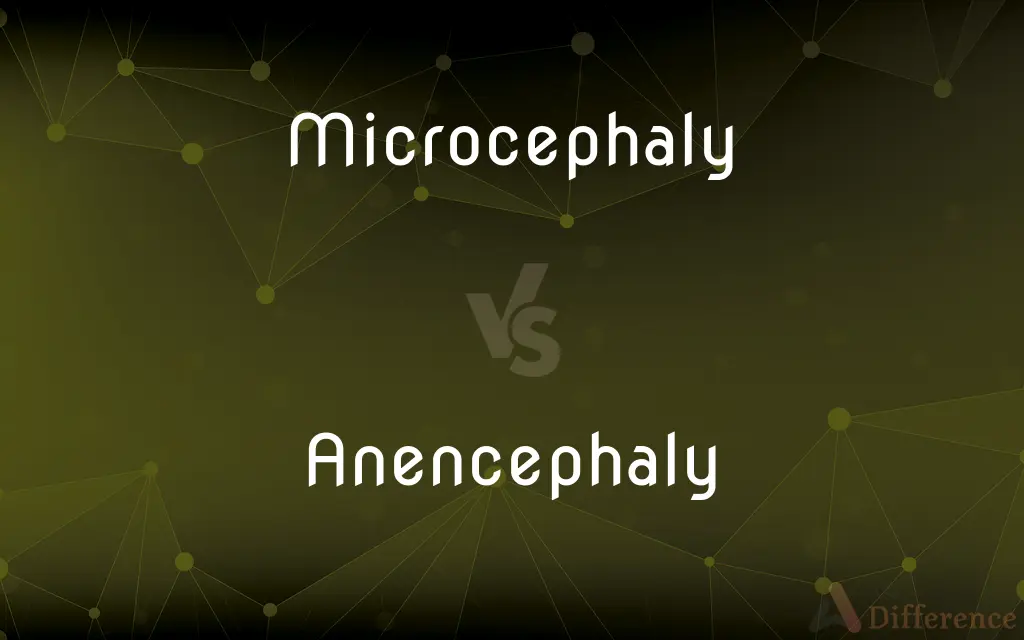Microcephaly vs. Anencephaly — What's the Difference?
By Fiza Rafique & Maham Liaqat — Updated on March 15, 2024
Microcephaly is a condition where a baby's head is significantly smaller than expected, often due to abnormal brain development, while anencephaly is severe form of neural tube defect where a major portion of the brain, skull, & scalp is absent at birth.

Difference Between Microcephaly and Anencephaly
Table of Contents
ADVERTISEMENT
Key Differences
Microcephaly is a neurological condition where an infant's head is significantly smaller than the heads of other children of the same age and gender. This condition can result from a variety of genetic and environmental factors, including infections during pregnancy, exposure to toxins, and severe malnutrition. Whereas anencephaly is a more severe neural tube defect characterized by the absence of a major portion of the brain, skull, and scalp. Occurring during embryonic development, anencephaly results from the neural tube not closing completely.
Infants with microcephaly often have developmental issues and may have problems with their brain development as they grow. The severity of these complications can vary widely; some children may experience mild delays, while others may have significant intellectual disability and physical challenges. On the other hand, anencephaly is a fatal condition, with affected infants typically being stillborn or dying shortly after birth.
The diagnosis of microcephaly can sometimes be made before birth through prenatal ultrasound, but it is more commonly diagnosed after birth based on the measurement of the head circumference. This contrasts with anencephaly, which can often be detected during pregnancy with routine ultrasound imaging, allowing for early diagnosis due to the significant physical abnormalities associated with the condition.
Treatment and management of microcephaly focus on managing its symptoms and supporting the child’s development and well-being through therapies and educational interventions. Since anencephaly is a fatal condition, management typically focuses on providing comfort care for the infant and support for the family during this extremely difficult time.
Prevention strategies for microcephaly include proper vaccination, avoiding exposure to harmful substances during pregnancy, and ensuring adequate nutrition. Whereas for anencephaly, prevention focuses on the mother taking recommended doses of folic acid before and during early pregnancy to reduce the risk of neural tube defects.
ADVERTISEMENT
Comparison Chart
Definition
A condition characterized by a smaller than normal head size.
A severe neural tube defect with the absence of a large part of the brain and skull.
Causes
Genetic factors, infections during pregnancy, exposure to toxins.
Neural tube not closing completely during early pregnancy.
Prognosis
Varies; some live with mild to severe disabilities.
Fatal; infants are stillborn or die shortly after birth.
Diagnosis
Can be prenatal or postnatal, often measured by head circumference.
Often detected through prenatal ultrasound.
Treatment/Management
Symptom management, therapies, educational interventions.
Comfort care for the infant, support for the family.
Compare with Definitions
Microcephaly
A condition where the head circumference is significantly smaller than average for age.
The pediatrician diagnosed the infant with microcephaly after noting the small head size.
Anencephaly
Results from the neural tube failing to close completely during early pregnancy.
Adequate folic acid intake is crucial to prevent neural tube defects like anencephaly.
Microcephaly
Often associated with developmental delays and intellectual disabilities.
Children with microcephaly may require specialized educational programs.
Anencephaly
Detected through routine prenatal ultrasound imaging.
Anencephaly can often be diagnosed before birth through detailed ultrasound examinations.
Microcephaly
Can be caused by a variety of genetic and environmental factors.
Zika virus infection during pregnancy is a known cause of microcephaly.
Anencephaly
A fatal condition where a baby is born without parts of the brain and skull.
Anencephaly was detected in the fetus during the second trimester ultrasound.
Microcephaly
Diagnosis can be made through measuring head circumference after birth.
Regular head circumference measurements can help in early diagnosis of microcephaly.
Anencephaly
Management involves providing comfort care to the infant.
Comfort care for an infant with anencephaly focuses on minimizing suffering.
Microcephaly
Management focuses on supportive care and therapies.
Physical therapy is a key component of managing microcephaly in children.
Anencephaly
Infants may be stillborn or die shortly after birth.
Infants with anencephaly typically have a very short life span after birth.
Microcephaly
Microcephaly (from New Latin microcephalia, from Ancient Greek μικρός mikrós "small" and κεφαλή kephalé "head") is a medical condition involving a shorter-than-normal head. Microcephaly may be present at birth or it may develop in the first few years of life.
Anencephaly
Anencephaly is the absence of a major portion of the brain, skull, and scalp that occurs during embryonic development. It is a cephalic disorder that results from a neural tube defect that occurs when the rostral (head) end of the neural tube fails to close, usually between the 23rd and 26th day following conception.
Microcephaly
Abnormal smallness of the head.
Anencephaly
Congenital absence of most of the brain and spinal cord.
Microcephaly
A neurological disorder in which the person affected has an abnormally small head due to a failure of brain growth.
Anencephaly
A lethal birth defect in which most of the brain and parts of the skull are missing; absence of the encephalon.
Microcephaly
An abnormally small head and underdeveloped brain
Anencephaly
A defect in brain development resulting in small or missing brain hemispheres
Common Curiosities
What causes microcephaly?
Causes include genetic abnormalities, infections during pregnancy like Zika virus, exposure to toxins, and severe malnutrition.
What is anencephaly?
Anencephaly is a severe form of neural tube defect where most of the brain and skull do not develop.
What is microcephaly?
Microcephaly is a condition where a baby’s head is significantly smaller than expected, often linked to abnormal brain development.
Can microcephaly be treated?
While there's no cure, treatment focuses on managing symptoms and supporting development through therapies and educational interventions.
How is microcephaly diagnosed?
It can be diagnosed before or after birth, usually by measuring the head circumference and comparing it to standard growth charts.
What causes anencephaly?
It occurs when the neural tube doesn't close completely during early pregnancy, though the exact cause is often unknown.
Can children with microcephaly lead normal lives?
Outcomes vary; some children may have mild symptoms and lead relatively normal lives, while others may require lifelong care.
What are the treatment options for anencephaly?
There is no treatment for anencephaly; management focuses on comfort care for the infant.
How is anencephaly diagnosed?
It is often detected through prenatal ultrasound imaging.
Can anencephaly be prevented?
Taking folic acid supplements before and during early pregnancy can reduce the risk of neural tube defects like anencephaly.
How common is microcephaly?
Its prevalence varies by region and cause, but outbreaks of related infections can increase incidence rates.
Why is folic acid important for preventing anencephaly?
Folic acid plays a key role in cell and neural tube development, and its adequate intake can significantly reduce the risk of neural tube defects.
How common is anencephaly?
It is less common than microcephaly but is among the most severe neural tube defects.
Is there any link between microcephaly and genetics?
Yes, certain genetic disorders and mutations can cause or increase the risk of microcephaly.
Are there any preventive measures for microcephaly?
Yes, including avoiding infections during pregnancy, reducing exposure to harmful substances, and ensuring proper nutrition.
Share Your Discovery

Previous Comparison
Farm vs. Barn
Next Comparison
Histopathology vs. CytologyAuthor Spotlight
Written by
Fiza RafiqueFiza Rafique is a skilled content writer at AskDifference.com, where she meticulously refines and enhances written pieces. Drawing from her vast editorial expertise, Fiza ensures clarity, accuracy, and precision in every article. Passionate about language, she continually seeks to elevate the quality of content for readers worldwide.
Co-written by
Maham Liaqat













































